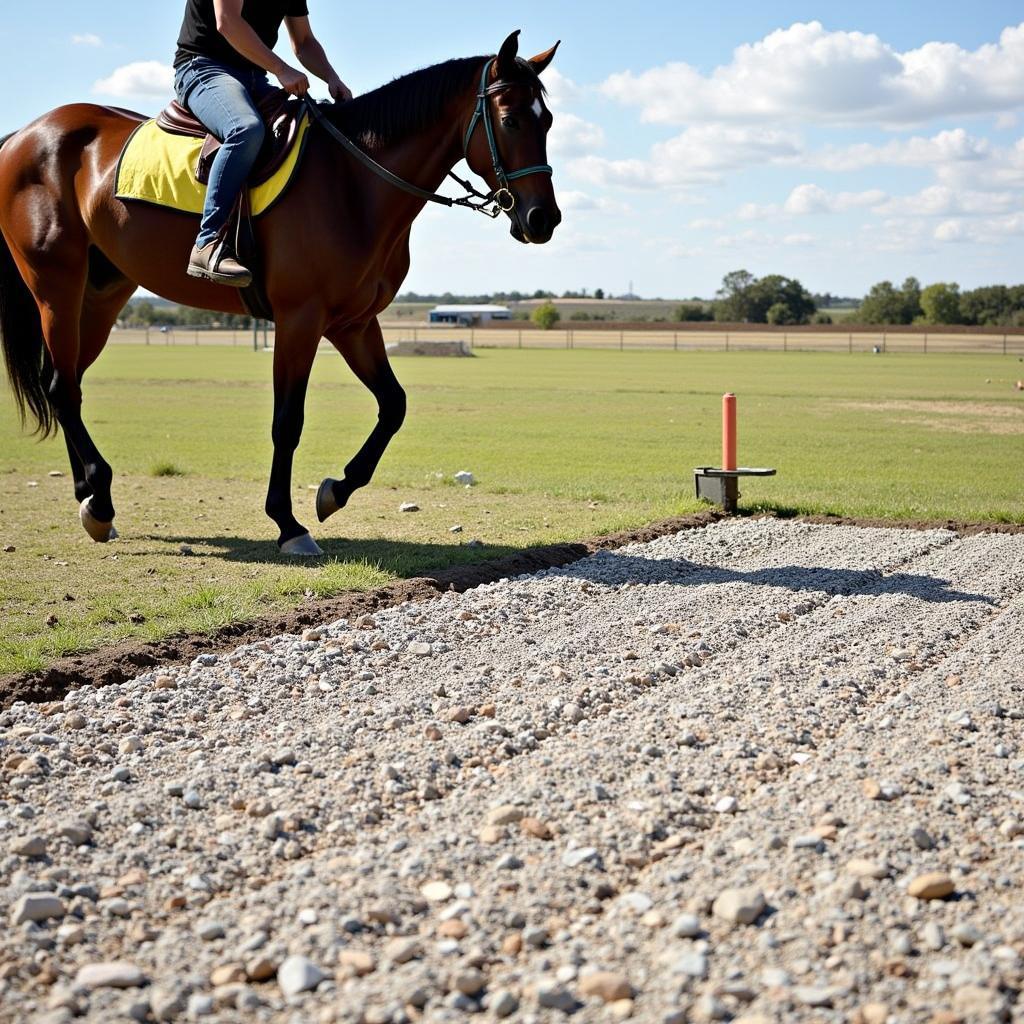A well-maintained riding arena, or Rite Track For Horses, is crucial for the safety and performance of both horse and rider. Whether you’re a seasoned equestrian or just starting out, understanding the key elements of a good rite track for horses is essential. This article will delve into the critical aspects of constructing and maintaining the ideal surface for your equine partner.
If you’re looking to enhance your riding experience, consider checking out our selection of mechanical horses for sale. mechanical horses for sale
Understanding the Importance of a Good Rite Track for Horses
The footing of your rite track for horses significantly impacts your horse’s leg health, movement, and overall performance. A poorly maintained surface can lead to injuries, ranging from minor strains to serious tendon and ligament problems. A proper rite track for horses provides consistent footing, reducing the risk of slips, trips, and falls. This consistency allows your horse to move freely and confidently, promoting correct biomechanics and preventing unnecessary stress on their joints. Beyond safety, a good surface also influences how effectively your horse can perform specific movements, such as turns, stops, and lateral work.
Key Components of a Rite Track for Horses
Building the perfect rite track for horses involves careful consideration of several factors. The base, the footing material, and ongoing maintenance all contribute to the overall quality of the surface.
The Base: A Solid Foundation
A stable, well-drained base is paramount. A compacted layer of gravel or crushed stone provides a solid foundation that prevents the riding surface from shifting or becoming uneven. Proper drainage is essential to prevent waterlogging, which can lead to a slippery and unstable surface.
Footing Material: Choices and Considerations
The choice of footing material depends on various factors, including discipline, climate, and budget. Popular options include sand, wood chips, and synthetic materials. Each material offers unique characteristics in terms of cushioning, traction, and maintenance requirements.
- Sand: A cost-effective option, sand provides good cushioning but requires regular watering and maintenance to prevent dust.
- Wood Chips: Wood chips offer excellent cushioning and drainage but decompose over time and may require more frequent replenishment.
- Synthetic Materials: Synthetic surfaces offer consistent footing and require less maintenance but come with a higher initial cost.
Maintenance: Keeping Your Rite Track in Top Condition
Regular maintenance is crucial to preserving the integrity of your rite track for horses. This includes:
- Watering: Regular watering helps to maintain moisture content and prevent dust.
- Dragging: Dragging levels the surface and removes manure and debris.
- Raking: Raking helps to loosen compacted areas and redistribute the footing material.
- Adding Footing: Replenishing the footing material as needed ensures consistent depth and cushioning.
 Rite Track Base Preparation: Laying the Foundation for a Safe and Effective Riding Surface
Rite Track Base Preparation: Laying the Foundation for a Safe and Effective Riding Surface
For horse racing enthusiasts, you can find information about Sonoma County horse racing on our website. sonoma county horse racing
Common Rite Track Problems and Solutions
Understanding potential problems and their solutions is vital for maintaining a safe and effective rite track for horses.
Dust Control
Excessive dust can irritate both horse and rider respiratory systems. Regular watering and the addition of dust control agents can help to mitigate this issue.
Drainage Issues
Poor drainage can lead to a muddy, unstable surface. Improving drainage may involve installing drainage systems or adjusting the slope of the arena.
Compaction
Compaction can make the surface hard and unforgiving. Regular raking and aeration can help to alleviate compaction.
Expert Insights on Rite Track Maintenance
“Proper maintenance is not just about aesthetics; it’s about the health and safety of your horse,” says Dr. Emily Carter, DVM, specializing in equine sports medicine. “A well-maintained rite track for horses reduces the risk of injuries and contributes to optimal performance.”
Thinking about getting a mini horse? Browse our selection of mini horses for sale in California. mini horses for sale california
Choosing the Right Footing Material
Choosing the appropriate footing material for your rite track for horses requires careful consideration of your specific needs and circumstances. John Miller, a renowned equestrian facility designer, advises, “Consider your discipline, climate, and budget when selecting footing material. There’s no one-size-fits-all solution.”
Conclusion
Creating and maintaining the perfect rite track for horses is a continuous process that requires attention to detail and a commitment to providing a safe and effective riding environment. By understanding the key components of a good rite track for horses and implementing proper maintenance practices, you can ensure the well-being and performance of your equine partner. Investing in a quality rite track is an investment in your horse’s future.
FAQ
-
What is the best footing material for a rite track? There’s no single best material; it depends on your individual needs and circumstances.
-
How often should I water my rite track? Watering frequency depends on climate and footing material.
-
How often should I drag my rite track? Dragging should be done regularly, ideally after each use.
If you’re interested in horse racing, you can check out information on Fredericksburg horse races. fredericksburg horse races Also, check out our blog post on Band of Horses Bogarts. band of horses bogarts
For support, contact us at Phone Number: 0772127271, Email: [email protected], or visit our address: QGM2+WX2, Vị Trung, Vị Thuỷ, Hậu Giang, Việt Nam. We have a 24/7 customer support team.